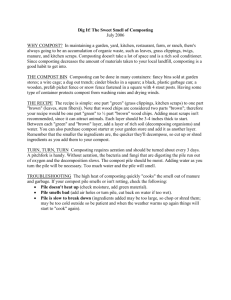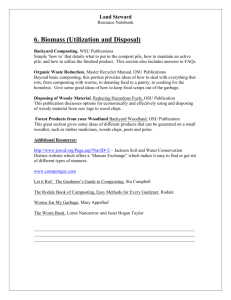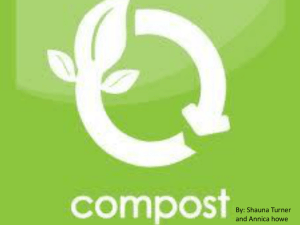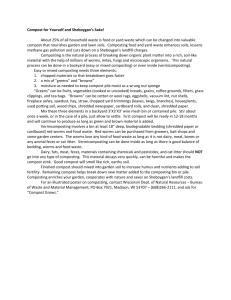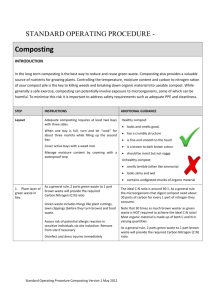Composting at home
advertisement
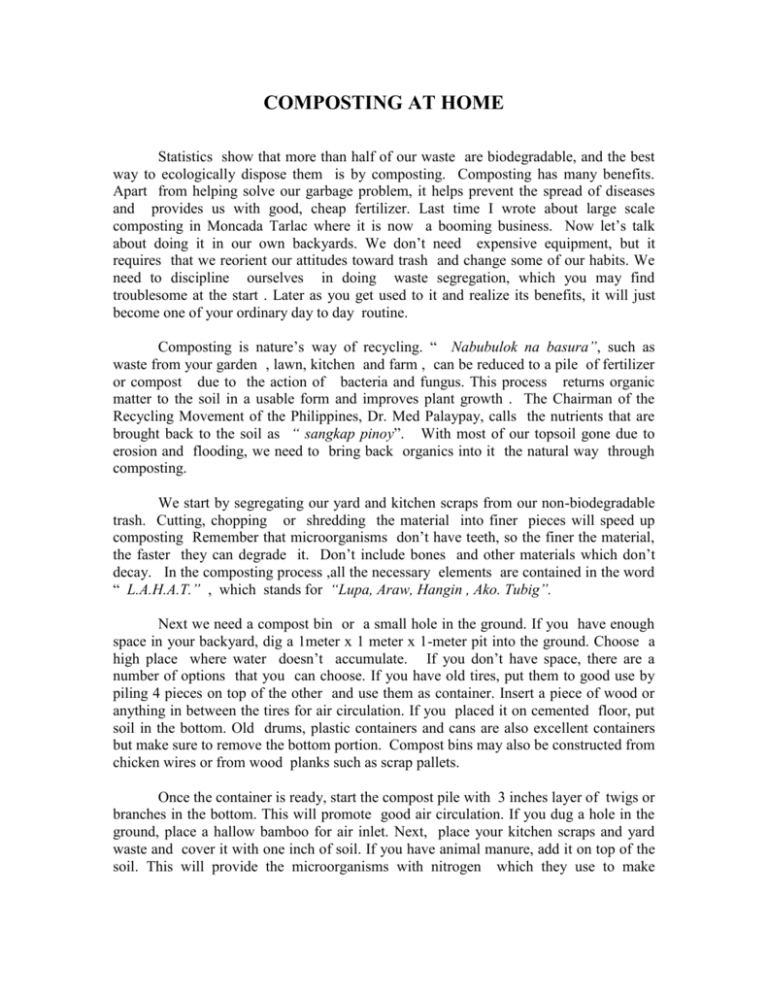
COMPOSTING AT HOME Statistics show that more than half of our waste are biodegradable, and the best way to ecologically dispose them is by composting. Composting has many benefits. Apart from helping solve our garbage problem, it helps prevent the spread of diseases and provides us with good, cheap fertilizer. Last time I wrote about large scale composting in Moncada Tarlac where it is now a booming business. Now let’s talk about doing it in our own backyards. We don’t need expensive equipment, but it requires that we reorient our attitudes toward trash and change some of our habits. We need to discipline ourselves in doing waste segregation, which you may find troublesome at the start . Later as you get used to it and realize its benefits, it will just become one of your ordinary day to day routine. Composting is nature’s way of recycling. “ Nabubulok na basura”, such as waste from your garden , lawn, kitchen and farm , can be reduced to a pile of fertilizer or compost due to the action of bacteria and fungus. This process returns organic matter to the soil in a usable form and improves plant growth . The Chairman of the Recycling Movement of the Philippines, Dr. Med Palaypay, calls the nutrients that are brought back to the soil as “ sangkap pinoy”. With most of our topsoil gone due to erosion and flooding, we need to bring back organics into it the natural way through composting. We start by segregating our yard and kitchen scraps from our non-biodegradable trash. Cutting, chopping or shredding the material into finer pieces will speed up composting Remember that microorganisms don’t have teeth, so the finer the material, the faster they can degrade it. Don’t include bones and other materials which don’t decay. In the composting process ,all the necessary elements are contained in the word “ L.A.H.A.T.” , which stands for “Lupa, Araw, Hangin , Ako. Tubig”. Next we need a compost bin or a small hole in the ground. If you have enough space in your backyard, dig a 1meter x 1 meter x 1-meter pit into the ground. Choose a high place where water doesn’t accumulate. If you don’t have space, there are a number of options that you can choose. If you have old tires, put them to good use by piling 4 pieces on top of the other and use them as container. Insert a piece of wood or anything in between the tires for air circulation. If you placed it on cemented floor, put soil in the bottom. Old drums, plastic containers and cans are also excellent containers but make sure to remove the bottom portion. Compost bins may also be constructed from chicken wires or from wood planks such as scrap pallets. Once the container is ready, start the compost pile with 3 inches layer of twigs or branches in the bottom. This will promote good air circulation. If you dug a hole in the ground, place a hallow bamboo for air inlet. Next, place your kitchen scraps and yard waste and cover it with one inch of soil. If you have animal manure, add it on top of the soil. This will provide the microorganisms with nitrogen which they use to make proteins. Sprinkle with water as often as necessary to keep the contents moist, but not soaking wet. Within a few days, the pile will decrease in size and heat up to about 140 degrees Fahrenheit killing harmful organisms and weed seeds. This is a good sign that the heap is working properly. For best results, fork the materials into a new pile, turning the outside of the heap into the middle portion. If the pile has a bad odor, it is a sign that there is not enough air. Turn it or provide air passages. If the center of the heap is dry, there’s not enough water so moisten it and turn the pile. If the pile is damp but doesn’t heat up, it lacks nitrogen so add animal manure. Composting may be completed in 1 or 2 months. It is ready when it is dark brown, crumbly and earthy smelling. If it is done right, you will see that there’s no smell, no flies and no cockroaches. I visited the house of Mrs. Luz Sabas, founder of the Recycling Movement, and saw a tire compost bin right inside their laundry area beside the kitchen. The area is clean and has no bad odor. Another good model is the Barangay Sun Valley, Paranaque composting project. Their community size project is inside a subdivision and right at the back of the Barangay Hall, attesting to it’s cleanliness. Follow nature’s rhythm, and you’ll reap its benefits . Compost your waste.
